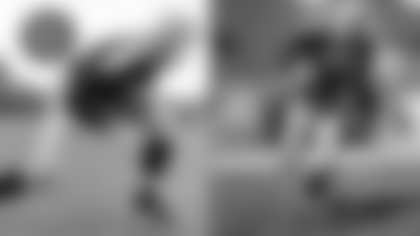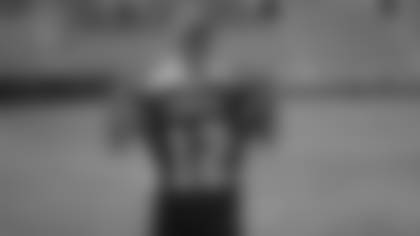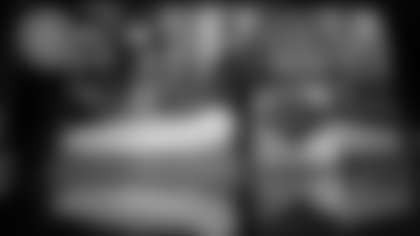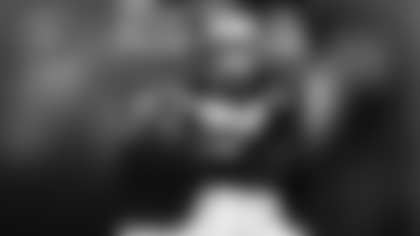First in a seven-part series of "best of" drafts in Packers history.
Curly Lambeau oversaw the Green Bay Packers' first 15 NFL Drafts from 1936-50.
But even before that when there was no draft, Lambeau was among the first pro coaches to establish a network of alumni and college coaches – most of them, like Lambeau, with ties to Knute Rockne and Notre Dame – to send him tips and reports on college prospects. What's more, Lambeau also was one of – if not the first – NFL coach to scout college seniors in person, namely at the East-West Shrine Game in San Francisco, starting in the 1920s.
Not surprisingly, he was a step ahead of most of his contemporaries when the first draft was held in 1936 and for several years thereafter. No question, Lambeau's early draft hauls played a huge part in him winning his last three NFL championships in 1936, '39 and '44.
Lambeau hit a bullseye on three of his early No. 1s: guard Russ Letlow in 1936, halfback Cecil Isbell in 1938 and tackle Dick Wildung in 1943, although the latter was unable to play until three years later when he was discharged from the Navy.
Lambeau similarly profited when he unearthed such sleepers as halfbacks Tony Canadeo, a ninth-round selection out of Gonzaga in 1941, and Irv Comp, a third-round pick from St. Benedict's of Kansas in 1943.
Lambeau's 1938 draft, which also produced Packers Hall of Famers, halfback Andy Uram and guard Pete Tinsley; and his '43 draft, which included halfbacks Roy McKay and Packers Hall of Famer Bob Forte in addition to Wildung and Comp were two of his best.
But Lambeau's most lucrative draft was 1939, when he acquired center-linebacker Charley Brock of Nebraska in the second round and blocking back-defensive end Larry Craig of South Carolina in the sixth round.
While Don Hutson was the showstopper of those 1939 and '44 champs, Brock and Craig formed their backbone.
As for his later drafts, Lambeau didn't fare nearly as well, mostly due to the wartime commitments of his choices and competition from the All-America Football Conference. The Packers lost their No. 1 draft picks in 1946 and '47 when they were outbid for their services by their AAFC rivals.
Arguably, Lambeau's best choice over his last seven drafts was Rice quarterback Tobin Rote, taken in the second round of his last draft, held 10 days before he submitted his resignation as Packers coach and general manager.

Fans can now register for free entry to the 2025 NFL Draft by downloading the NFL OnePass app or by registering online!
Brock & Craig: Products of Lambeau's Notre Dame connections
By having a major and immediate impact, Brock and Craig offset a devastating turn of events involving the Packers' No. 1 pick, Minnesota fullback Larry Buhler.
A week after being selected as the ninth overall choice, Buhler (6-2, 217) suffered a broken pelvis, chest wounds, several cracked ribs and multiple lacerations in a near-fatal automobile accident near the Minnesota state fairgrounds in St. Paul. He was hospitalized for more than seven weeks and lost 40 pounds.
As a result, Buhler played in only three games as a rookie. Thereafter, he was the Packers' third-string fullback in 1940 and a starter for seven games as a blocking quarterback in 1941 before retiring to his mink farm in Minnesota.
The Packers chose Brock on the recommendation of Ivan "Tiny" Cahoon, who had played tackle for Lambeau and the Packers from 1926-29. Before that, Cahoon had played college football at Gonzaga under coach Gus Dorais, an All-American back at Notre Dame in 1913 when Rockne was his star end. Cahoon was coaching at Monmouth College in Illinois when he saw Brock play and passed on a good word to his former pro coach.
Like Isbell a year earlier, Craig's college coach, Rex Enright, learned the Notre Dame system under Rockne from 1923-25 and then played for the Packers in 1926-27. Lambeau drafted Craig, a farm boy from tiny Six Mile, S.C., on Enright's recommendation. At Notre Dame, Enright's teammates included Four Horseman Jim Crowley and 1925 team captain Tom Hearden, both products, like Lambeau, of Green Bay East High School.
Bob Snyder, former Chicago Bears quarterback and Lambeau's backfield coach in 1949 (Christl interview, 1997): "Curly depended on the guys who played for him in 1919 and up through the 1920s. They'd write him and say, 'You gotta get this guy.' There were no scouting systems."
Cahoon, on scouting Brock (Green Bay Press-Gazette, March 14, 1939): "He is one of the very best centers I ever have seen. I took a busman's holiday after the Monmouth-Knox game, which was played on Friday night last fall and took in the Nebraska-Iowa game. I couldn't take my eyes from this Brock. His work on pass defense is uncanny. His weight is well over 200. And he seems tough as nails."
Enright, praising Craig in a letter to Lambeau before the draft: "Here's a sleeper. Grab this guy because he will set the league on its ears."
Mainstays of Lambeau's last two championship teams
As a rookie, Brock filled a need on both sides of the ball, created by the retirement of George Svendsen and the uncertain status of his younger brother Earl "Bud" Svendsen.
The Svendsen brothers had manned the center and linebacker positions in 1937, but both retired after that season at the respective ages of 25 and 23 to go into coaching.
George, who stood 6-foot-4 and weighed 230 pounds, was such a dominating force and so highly regarded in league circles that despite playing only three seasons, he was the only other center besides New York Giants all-time great Mel Hein to be named to the NFL's 1930s All-Decade Team.
Bud was a standout in the 1937 College All-Star Game and spelled his brother as a rookie. Thanks to some behind the scenes maneuvering by Lambeau to cover-up for a season-long weakness at center, Bud also was recruited to play one game in 1938, the NFL championship. Rusty or not, he was praised in the Press-Gazette for being the Packers' best performer in their loss to the Giants.
In 1939, Bud returned to the Packers and started 10 of 11 games, but Brock played extensively, if not more, and was regarded by Lambeau as the better of the two, certainly on defense. A year later, Bud was released. By then, George also had come out of retirement and played two more seasons but also in Brock's shadow.
As a rookie, in 10 regular-season games, Brock intercepted eight passes and then picked off two more at pivotal points as the Packers beat the Giants, 27-0, in the 1939 NFL Championship Game. On the first one, the Giants had the ball at the Packers' 9-yard line just before the half when Brock's pick preserved their 7-0 lead. The other came in the third quarter with the Giants in possession at the Packers' 16-yard line.
A year later, Collyer's Eye, a Chicago-based sports newspaper, chose Brock as its all-pro center. The Bears' Bulldog Turner made second team.
Sportswriter F.B. Field, who oversaw the selections of one of the most respected all-pro teams at the time (Collyer's Eye & Baseball World, Dec. 7, 1940): "In our opinion Bulldog Turner is the greatest center prospect ever to enter the National Football League. The Texan has a long way to come yet to be a finished performer, especially as a tackler. So we are placing, Charley Brock of Green Bay on the first team."
Lambeau (Chicago Tribune, July 18, 1945): "Craig and Charley Brock to my mind have been vastly underrated players, at least in the public eye. (Charley) is the best center in professional football. I include Bulldog Turner… I have a great deal of respect for Bulldog Turner. He is fast, too, but does not maneuver with the skill of Brock, who has the coordination of a halfback."
Packers Hall of Fame halfback Tony Canadeo on Brock, his teammate for six years (Green Bay Press-Gazette, May 26, 1987): "Charley was one of the greatest centers in the NFL. I still don't know why he isn't in the (Pro Football) Hall of Fame."
Thanks to Craig's play as a rookie, the Packers were vastly improved at two positions. Most importantly, on defense, Craig solved what was the team's most glaring weakness in recent years. At a time when players went both ways, Hutson had been forced to play defensive end at 180 pounds over his first four seasons.
Thus, according to New York Times pro football writer Arthur Daley, "every team ran Hutson's end with impunity." At the same time, Hutson was taking what Isbell described as "a fearful beating" and even contemplated retirement after the 1938 season.
Craig, at 6-1, 211 pounds, had the size and raw strength to double as a blocking back on offense and end on defense, allowing Hutson to move to the backfield on that side of the ball. Craig's teammates nicknamed him "Superman," and based on what players from those years said, they considered him as valuable as Hutson.
After just one season, Lambeau declared that Craig, as the quarterback in his Notre Dame Box, was the best blocking back in the league.
In the wake of the Packers' victory in the 1939 championship, Isbell said, "It was won in the line," where the standouts included Baby Ray, the second-year undrafted, two-way free agent tackle, along with Craig on defense and Brock on offense, as well as linebacker.
Norman Cooper, who played against Hutson in college and the pros before launching a 12-year collegiate coaching career (10-Page Summary of Larry Craig's Career, Green Bay Packers, 1975): "Hutson, with his inability to stop plays at end, was quite a problem to Green Bay back then. He was brilliant offensively, but he just couldn't stand up under that pounding on defense."
Ray, 1940s NFL All-Decade tackle and four-time all-pro (Summary of Larry Craig's Career): "The more I think of Hutson, the more I think of another fellow who in my opinion is Pro Football's Forgotten Man. That's Larry Craig. Possibly few of you ever heard his name, yet to my mind he's right up there with Don Hutson as the most valuable player in pro football. Larry Craig is our blocking back at Green Bay. That's how he's listed in the program. Actually, though, he's the boy responsible for the remarkable success of Don Hutson. … Know what we called Larry Craig? We called him Hutson's Muscle! And let me tell you there isn't a more rugged, tougher, ready-to-go guy in pro football."
Washington Hall of Fame quarterback Sammy Baugh (Columbia (S.C.) State, April 30, 1975): "Any time anybody asks me who gave me the most trouble when I was attempting to pass, I always say Larry Craig. We could never handle him consistently. We tried to keep our best blocker on him, but he still rushed me harder than anyone I ever played against."
Los Angeles Rams Hall of Fame quarterback Bob Waterfield, when he picked Craig and the Bears' Ed Sprinkle as the defensive ends on his all-time, all-opponent team (Los Angeles Times, Jan. 12, 1952): "Craig was one of the best defensive ends I ever had the misfortunate to play against."
Sports columnist Al Abrams (Pittsburgh Post-Gazette, Dec. 23, 1944): "Ask any pro grid star who is the best blocking back in the National Football League and he will readily answer: Larry Craig of the Green Bay Packers."
Long term, Craig played 11 years, never missing a game, and Brock, nine. They played a key role again in 1944 when the Packers won their sixth and final NFL title under Lambeau.
But neither one ever received his due on all-pro teams.
In Craig's case, it was because he was officially listed as a quarterback in the days of 11-man all-pro teams but never threw a pass during his entire career. Yet, even as the substitution rules were liberalized during the 1940s, Craig remained one of the few 60-minute players in the game.
Brock had numbers – 28 career interceptions as a linebacker, including eight before it became an official stat – and a league-wide reputation for his ball-stripping ability, which contributed to his 13 fumble recoveries in just his last three seasons, when it became an official stat.
Officially, Brock is credited with only 20 interceptions. But if given credit for the other eight, he'd still be tied for the eighth most interceptions by a linebacker in NFL history. Considering Brock played more than 11 regular-season games only once and opposing teams never attempted more than 277 passes in any of those nine seasons, his interception total would seem to be a remarkable stat. By comparison, opponents attempted 565 passes against the Packers in 2024.
However, in history, just as he was when he played, Brock was overshadowed by the two most decorated centers of the NFL's Iron Man era: Hein and Turner.















